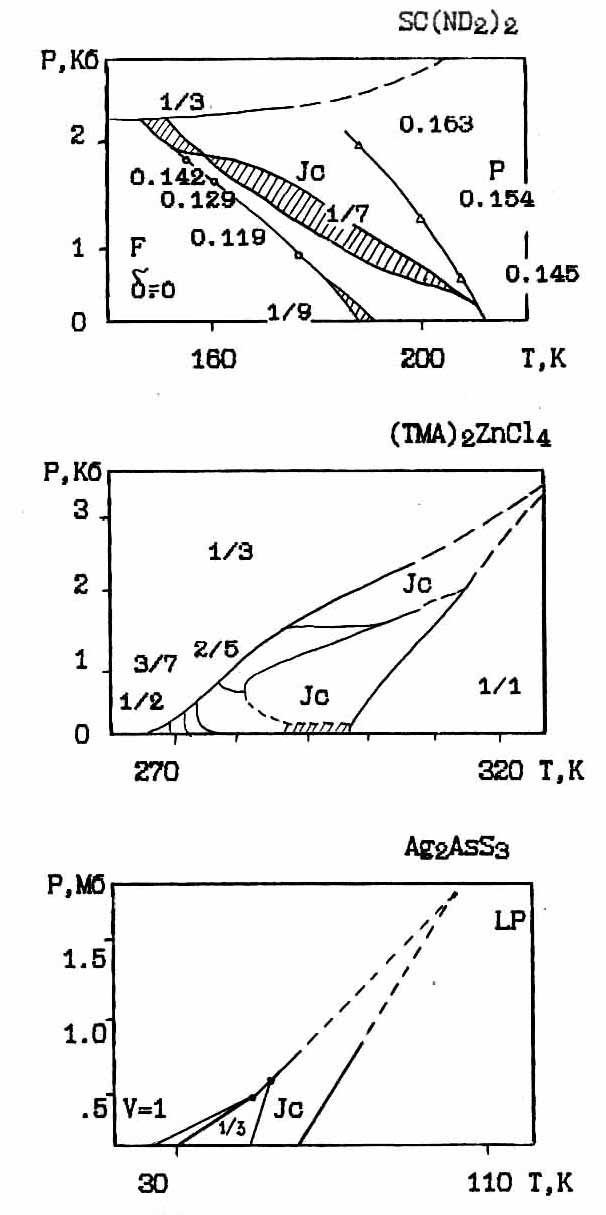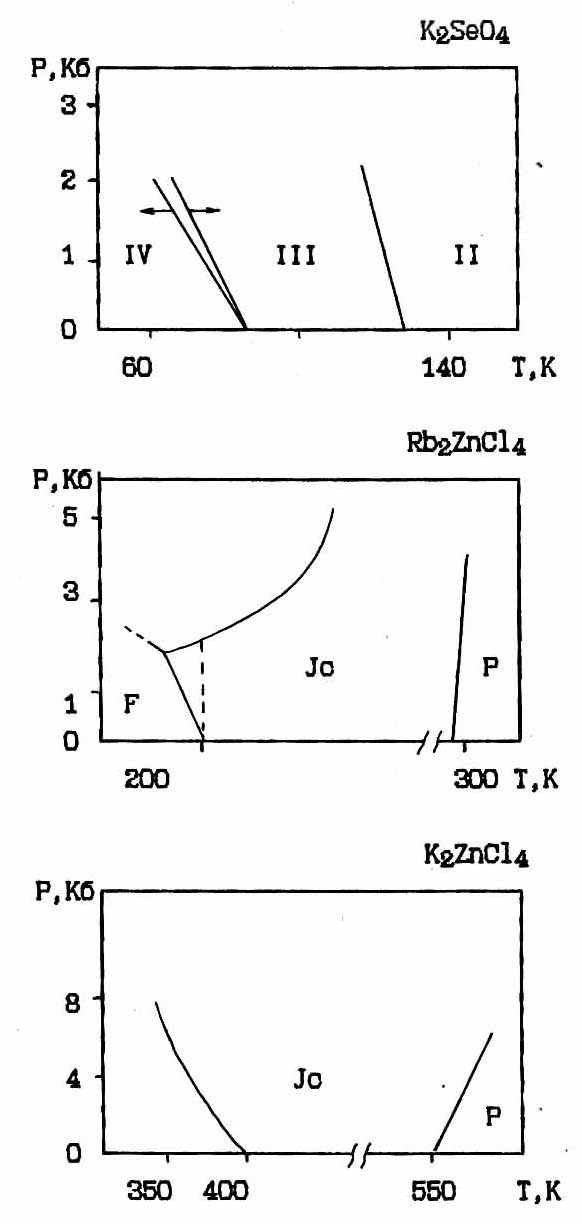SHEMETOV YEVGENY. STUDIES OF PHASE TRANSITIONS IN THE UNITED A2BX4 STRUCTURE β-K2SO4 METHOD NUCLEAR QUADRUPOLE RESONANCE
English abstract § 1.1 § 1.2 §1.3 § 1.4 § 2.1 § 2.2 §2.3 §2.4 § 3.1 § 3.2 § 3.3 § 3.4 § 4.1 § 4.2 § 4.3 § 4.4 Reference Template pdf abstract
§ 1.4. Investigation of incommensurate phases in dielectric crystals at high pressure.
After the initial accumulation of experimental information. Study of incommensurate phases in the temperature scale, its amount was insufficient to prove or disprove any of the theories disproportionate state. Efforts experiments were aimed at expanding research using other external parameters. One of them is thehydrostatic pressure
Fig. 1.7 and 1.8 shows the phase P-T diagram of some compounds. These diagrams have been prepared by various methods. The most important from the point of view of the structure are the diffraction data. One of the first studies of molecular dielectrics with an incommensurate phase at high pressure was performed on a crystal of thiourea SC(NH4)2 Fig.1.7 [53]. In this connection method neutron diffraction were tracked change in pressure of the wave vector of the incommensurate modulation. At atmospheric pressure, J C phase due to softening of one of the static modes in the center of the Brillouin zone. Under pressure dew point is marked deviation from the center of fashion, followed by a tripling of the unit cell volume.
In NaNO2 incommensurate phase is also associated with the softening of one of the modes of nature relaxation at zero frequency. In this connection disappears incommensurate phase at low pressures, is also assumed that the incommensurate phase in Cs2HgBr4 disappears when the load [54].
Any studies under pressure this class of compounds by RF unknown to us. Among the compounds having ferroelectric properties and having, as it turned out during our research, incommensurate phase, work on the high pressure NQR was held on proustite Ag2 AsS3 Fig.1.76 [56,57]. It has been suggested disappearance incommensurate pressurized state.

Figure 1.7. Phase diagrams of dielectrics: a) thiourea; b) (TMA)2ZnCl4; c) proustite.

Figure 1.8. P-T phase diagrams of compounds A 2BX4 obtained by -measurements.
P-T phase diagrams of some of the compounds A2BX4 were initially identified using dielectric measurements. Figure. l.8a data obtained are presented in [58], and Fig.1.8b in [59]. The first type of compounds with a structure β-K2SO4 studied in detail the crystal was pressurized {TMA}2ZnCl4 (Fig.1.7b) [55]. Neytron diffraction method it was filmed isothermal variation of the wave vector qS, traced the region of existence of the incommensurate phase and found a structure with multiple larger unit cell. Character changes qS adequate behavior such as "devil's staircase". Thus by the time of our study were quite scarce data on disproportionate phases under pressure, and most of them have been published during the execution of our program.
From the analysis of the physics of incommensurate systems in dielectrics family A2BX4 structure β-K2SO4, it is seen that there is a broad range of issues requiring further experimental clarification. First, the lack of detailed structural data on family type β-K2SO4, where at the beginning of our work was carried out initial studies of all seven of its representatives (of 25 projected).
The resulting macroscopic diffraction and radio spectroscopy data indicate significant differences in the structural transformation of compounds as the wave vector and sequence of structural transformations. In various compounds below the transition to the incommensurate phase was observed significantly different multiplicity spectra and different degree of ordering of the structure dynamics. Not quite clear was the question of uniformity of phase transitions P « JC and JC ⇔ F. Also highlights some of the difficulties in explaining the shape of the line in the incommensurate phase on the basis of continuous semiclassical theory Dzyaloshinsky-Landau, whereas non-classical type theory Izinga indicate the behavior of complex or simple type "devil's staircase".
Because NQR method, in many cases allows a quantitative interpretation of the structural and dynamic transformations near phase transitions, as well as to feel a slight change in the local structural environment of the quadrupole probe subsystem of the crystal, there is a strong, virtually confirmed the reasons for its use in the study of the subject systems. Even the simplest information to monitor changes in multiplicity intensity and width NQR lines contains important information about changes in the crystal structure and chemical environment, the nature of phase transitions and spin dynamics. More detailed studies, such as the study of the frequency dependences of ν (T), I (T), uv (T) and the change of the relaxation times TQ TQ1 and TQ2, and others, allows to draw conclusions about the type and nature of the motion of molecular segments or electronic excitations directions of chemical bonds, etc. The advantage of NMR NQR before the winner is sensitivity at high frequencies >10 MHz, where exactly are the NQR frequency halogen nucleus belonging to the majority of the members of the family A2BX4. Furthermore NQR has the advantage of relative simplicity of the experimental formulation, especially at high hydrostatic pressure. This simplification, however, made up for the back while trying to implement a tribute to the experimental data in the options atomic motions as a microscopic theory of the quadrupole relaxation is based on the specific solid model and crystal chemical bond theory, which, as you know, in these compounds, only beginning to be developed. NQR advantage before EPR - not violated local electronic environment of the matrix.
Tetrahedral or close to the structure of segmentsBX4 neplotnoupakovannoy structure β-K2SO4, allows us to expect the possibility of significant local and collective distortion when the external parameters. And it can be assumed that with the NQR method should be obtained valuable, in terms of solid state physics and phase transitions, information. Experimental task in the first stage is a generalized phase diagram β-K2SO4. On the other hand one can study the structure of the electronic environment of the nucleus - a task more difficult and laborious, and most successfully solved in the presence of all primary data from NQR, NMR and diffraction methods for all compounds of group A2BX4 structure β-K2SO4.
: We have formulated the following research areas:
1) Controlled diffraction and NQR synthesis of compounds A2BX4 major cations and anions (A = NH4, Cs; B = J), near the border the crystal structure stability β-K2SO4, to detect them with this structure sequence of phase transitions involving . incommensurate phase.
2) Application of the method of NQR under high pressure to determine the domains of existence of the structural evolution of J-O phase in Rb2ZnBr4 under high hydrostatic pressure. A more detailed study of the NQR (in combination with other methods) Rb2ZnBr4, to find in this connection behavior such as "devil's staircase" or long-period structures.
3) Explanation of the reasons for the unsatisfactory description of the forms of radio frequency absorption lines in the incommensurate phase of Rb2ZnBr4.
In preliminary studies, after setting growth compounds A2BX4 with major ions and detection in a number of these structures β-K2SO4, scheduled tasks were also associated with an additional question:
4) Assessment of the degree of spin-phonon, spin-spin dynamics in the synthesized compounds.
English abstract § 1.1 § 1.2 §1.3 § 1.4 § 2.1 § 2.2 §2.3 §2.4 § 3.1 § 3.2 § 3.3 § 3.4 § 4.1 § 4.2 § 4.3 § 4.4 Reference Template pdf abstract